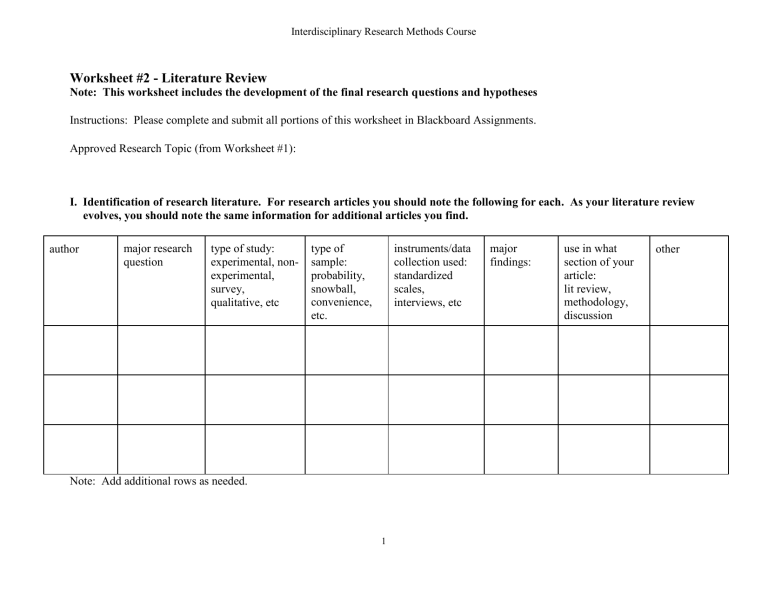
Interdisciplinary Research Methods Course Worksheet #2 - Literature Review Note: This worksheet includes the development of the final research questions and hypotheses Instructions: Please complete and submit all portions of this worksheet in Blackboard Assignments. Approved Research Topic (from Worksheet #1): I. Identification of research literature. For research articles you should note the following for each. As your literature review evolves, you should note the same information for additional articles you find. author major research question type of study: experimental, nonexperimental, survey, qualitative, etc type of sample: probability, snowball, convenience, etc. instruments/data collection used: standardized scales, interviews, etc Note: Add additional rows as needed. 1 major findings: use in what section of your article: lit review, methodology, discussion other Interdisciplinary Research Methods Course II. Integration of Research Literature Integration of findings from prior research produces a sophisticated and meaningful overview of the body of knowledge. Gaps in the body of knowledge identify the research problem that you are addressing. The purpose of your study is to address the research problem. The purpose provides the framework for the finalization of your research questions. A. Group the research studies identified above into at least 2 or 3 topic areas, and add the details below. Supporting points may include study findings relevant to the topic, findings inconsistent with other studies on the topic, consistent findings across the studies referenced, or limitations that impact the ability to support study conclusions. 1. a. b. c. (topic area): (supporting point): (supporting point): (supporting poin)t: 2. a. b. c. (topic area) 3. a. b. c. (topic area) 4. Etc.. etc.. etc (topic area) a. b. c. B. Theoretical discussion. What theories have been tested or developed through these studies? 1. 2. 3. (main point) (main point) Etc etc C. Gaps in the literature. This would be the same as limitations. (e.g. Have the studies focused on only a specific portion of the population?) 1. 2. 3. (main point) (main point) Etc etc 2 Interdisciplinary Research Methods Course III. Final development of the research problem statement, purpose statement, research questions and hypotheses. A. Final Problem Statement - Based upon your literature review, consider the gaps in literature. Think about populations who have not been studied or who have not been studied specifically, e.g., different ages, races, etc. What kinds of questions have not been researched? Are studies a mix of descriptive, exploratory, explanatory research with limited empirical studies? State the topic problem and add at least 3 supporting points. For example, why is this topic important? How will this study potentially impact theory and/or practice? 1. supporting point 2. supporting point 3. supporting point Note the significance and extent of the problem and add at least 3 supporting points found in the literature. 1. supporting point 2. supporting point 3. supporting point B. Final Purpose Statement – Indicate why your research is important. For example: Will it contribute to greater awareness of an issue, support a theory or theoretical concept, improve practice, or demonstrate how two concepts are related or not related? What do you intend to accomplish? Indicate how a quantitative and qualitative perspective will support the purpose of the proposed research. 3 Interdisciplinary Research Methods Course C. Research Questions/Hypotheses - Based upon the final problem and purpose of your study that have been identified as a result of your literature review, you need to finalize your quantitative and qualitative research questions. You also need to develop a research and null hypothesis for the quantitative research question. Qualitative Research Question: Quantitative Research Question: Research hypothesis: Null hypothesis: 4
